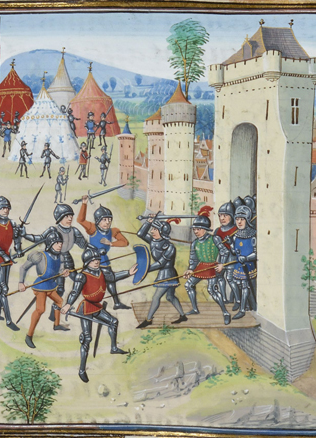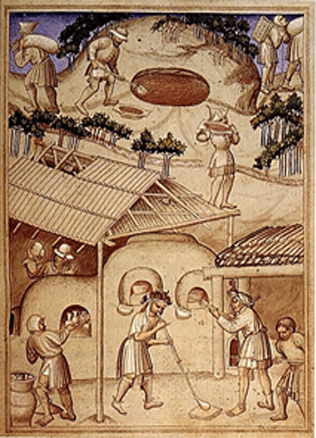Ploughing: Horses versus Oxen
Winter rye require new technologies and patience
Warm and wet weather that reached the territory of Lithuania in the beginning of the second millennium, during the so-called “mediaeval warm period”, was suitable for the formation of soil. It was then that the types of soil characteristic to the modern times developed. Landscapes became more open, because local people already used more advanced wide-blade axes to clear forests and woods in order to expand the areas of arable land. While analysing sediments of that time, scientists discover pollen of various grasses including a number of domesticated plants, weeds and other plants that usually grow in meadows and open pastures opening up after felling down the forest. Archaeological findings in the Samogitian Heights include the first traces of winter grain (rye) cultivation dating back to around 800 AD. Rye was becoming more and more popular in the agriculture alongside the older leguminous plants (such as peas, beans and vetches) and food grain (such as oats, summer wheat and millets). To some extent, the improvement of agricultural tools and systems of land cultivation was behind the introduction of rye. In addition to that, rye is resilient to colder and rain weathers, the harsher conditions that began dominating the region since the 13th century. The research of agricultural traditions in Livonia serve as a testimony that growing rye could guarantee sustainable harvests even in bad years.
Since winter rye has a longer vegetation period compared to that of summer grain (oat, barley and wheat), growing rye called for more advanced tools and technologies.
People had to work their fields properly and keep them fertile in order to grow rye there.
Hard work for daily bread
Farming tools and land cultivation systems are the two most discussed issues in the history of the Lithuanian agriculture. Historians, archaeologists and ethnographers have analysed the introduction of iron plough, two-blade ploughshare and the three-field system in old Lithuania. That is important, because these are the criteria of progress of Lithuanian agriculture at that time. According to historian Juozas Jurginis, the two-blade ploughshare was spreading in Lithuania in the 13th century. (His colleague Regina Volkaitė-Kulikauskienė suggests an earlier date, the beginning of the second millennium.)
The new ploughshare enabled a ploughman to produce a wider and deeper furrow and even to upturn the cut-off layer of soil. The efficiency and quality of land working was growing higher and people were able to begin cultivating fields less suitable for agriculture. Therefore, people started settling down in the Central Lithuanian Lowland (the basin of River Nevėžis) more actively in the first half of the 14th century.
The importance of the new ploughshare is evident given the fact that the same word, žagrė (a ploughshare), was used to name a fixed area of arable land in Lithuania. Jogaila, the king of Poland and the Grand Duke of Lithuania, used the word in his 1389 letter to bailiffs regarding the supplies to new churches. In the 16th century, one žagrė equalled one voloka (Lithuanian: valakas, Polish: włoka, Ruthenian: волока), or 21.36 hectares.
A plough, another important farming tool, was less effective compared to a ploughshare, because a plough could only furrow fields. It did not help to upturn soil, therefore fields required repeated ploughing along and across. The ploughshare, however, has not replaced the good old plough entirely, because the latter could be conveniently used to work light soils and to scarify fields that had been ploughed earlier. Supposedly, Lithuanians also used harrow to plough fields with certain types of soils, because a harrow could be equal to a plough in terms of efficiency. The 1230 treaty between Curonians and the city of Riga refers to that kind of tool, called egede. Depending on the type of soils, people used ploughshares made either of wood or of horn. The more effective iron ploughshares were spreading in the 14th century too, especially in the estates of the grand duke and less so among ordinary peasants. The only iron ploughshares so far have been found in the grand duke’s old residential castles in Vilnius, Maišiagala and Grodno.
Horses at war, oxen pull ploughs
Horse were used for ploughing in the period between the 13th and 15th century. The Lithuanian words arklas>arklys (meaning a plough and a horse) expressively reveal the relationship between a horse and his tool. Horses pulled ploughshares too. Later on, peasants began harnessing oxen for ploughing, and this tradition became quite widespread in the early 16th century. The analysis of cattle herds in Vilnius and around the city provide eloquent data on the matter. Cows constituted the majority of herds in the 14th and 15th century with oxen accounting for just several percent. This means that people would raise cows to expand and rejuvenate their herds and to ensure supplies of meat and milk. Oxen and calves were raised for meat too. The changes in the structure of herds in the 16th and 17th century points to extensive use of oxen for ploughing, because oxen accounted for more than a third of a herd. The similar trend of using oxen for ploughing instead of horses prevailed in Livonia. The changes, however, occurred earlier there as Livonians started ploughing with oxen in about 14th century.
At least two reasons were behind the use of oxen. First, using oxen usually led to higher work efficiency, because small-size Lithuanian horses often proved not strong enough to pull a ploughshare. The fact that the military tax was two times higher for those using oxen for ploughing rather than horses, reflects obvious differences in the efficiency of field work in the 16th-century Lithuania. Secondly, horses were vital for the military as the Grand Duchy of Lithuania was at war with the Muscovy and the Crimean Khanate since the late 15th century.
The modernisation of land cultivation: the routine crop rotation
The spread of rye and iron two-blade ploughshare prompted the development of land cultivation and led to the introduction of a more advanced three-field system in Lithuania. The dominating system of agriculture in the period between the 13th and the 15th century can be termed archaic three-field or primitive three-field. People used multiple fields, therefore they were unable to divide their lands into three more or less regular arable areas. They used plenty of scattered tiny plots of land for winter and summer crops while leaving some of them to rest and preparing the new one somewhere further away. Their fields were very different in terms of cultivated areas too, because the area of winter crops could be three times larger than that dedicated for summer grain and vice versa. Fields required rest, therefore people often used less than two thirds of their land to plant crops, sometimes just one sort of it, such as summer or winter grain. In other words, they used the same field to plant the same type of crops, although with breaks.
In the late 15th century, the grand duke’s estates began introducing the three-field system for winter grain, summer crops and fallow.
The system calls for an orderly rotation of crops: fallow land should be planted with winter grain, summer crops are to be sown in the last year’s field of summer plants, while the third field should be left fallow to rest and to become a field of winter grain in two years. The 16th-century land reform introduced the same system of agriculture in the whole of Lithuania.
Artūras Dubonis



